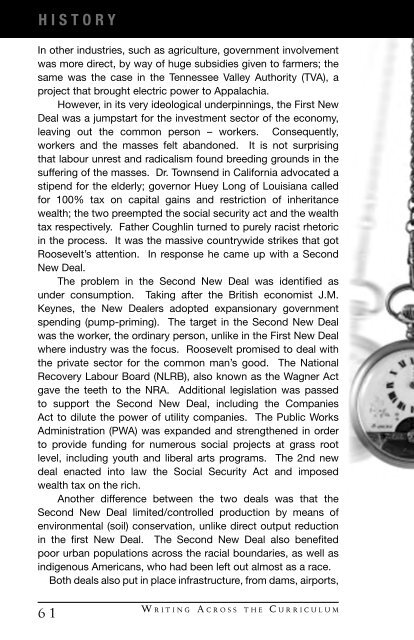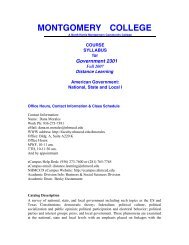2008 - Communication Across the Curriculum (CAC)
2008 - Communication Across the Curriculum (CAC)
2008 - Communication Across the Curriculum (CAC)
You also want an ePaper? Increase the reach of your titles
YUMPU automatically turns print PDFs into web optimized ePapers that Google loves.
H i s t o r y<br />
In o<strong>the</strong>r industries, such as agriculture, government involvement<br />
was more direct, by way of huge subsidies given to farmers; <strong>the</strong><br />
same was <strong>the</strong> case in <strong>the</strong> Tennessee Valley Authority (TVA), a<br />
project that brought electric power to Appalachia.<br />
However, in its very ideological underpinnings, <strong>the</strong> First New<br />
Deal was a jumpstart for <strong>the</strong> investment sector of <strong>the</strong> economy,<br />
leaving out <strong>the</strong> common person – workers. Consequently,<br />
workers and <strong>the</strong> masses felt abandoned. It is not surprising<br />
that labour unrest and radicalism found breeding grounds in <strong>the</strong><br />
suffering of <strong>the</strong> masses. Dr. Townsend in California advocated a<br />
stipend for <strong>the</strong> elderly; governor Huey Long of Louisiana called<br />
for 100% tax on capital gains and restriction of inheritance<br />
wealth; <strong>the</strong> two preempted <strong>the</strong> social security act and <strong>the</strong> wealth<br />
tax respectively. Fa<strong>the</strong>r Coughlin turned to purely racist rhetoric<br />
in <strong>the</strong> process. It was <strong>the</strong> massive countrywide strikes that got<br />
Roosevelt’s attention. In response he came up with a Second<br />
New Deal.<br />
The problem in <strong>the</strong> Second New Deal was identified as<br />
under consumption. Taking after <strong>the</strong> British economist J.M.<br />
Keynes, <strong>the</strong> New Dealers adopted expansionary government<br />
spending (pump-priming). The target in <strong>the</strong> Second New Deal<br />
was <strong>the</strong> worker, <strong>the</strong> ordinary person, unlike in <strong>the</strong> First New Deal<br />
where industry was <strong>the</strong> focus. Roosevelt promised to deal with<br />
<strong>the</strong> private sector for <strong>the</strong> common man’s good. The National<br />
Recovery Labour Board (NLRB), also known as <strong>the</strong> Wagner Act<br />
gave <strong>the</strong> teeth to <strong>the</strong> NRA. Additional legislation was passed<br />
to support <strong>the</strong> Second New Deal, including <strong>the</strong> Companies<br />
Act to dilute <strong>the</strong> power of utility companies. The Public Works<br />
Administration (PWA) was expanded and streng<strong>the</strong>ned in order<br />
to provide funding for numerous social projects at grass root<br />
level, including youth and liberal arts programs. The 2nd new<br />
deal enacted into law <strong>the</strong> Social Security Act and imposed<br />
wealth tax on <strong>the</strong> rich.<br />
Ano<strong>the</strong>r difference between <strong>the</strong> two deals was that <strong>the</strong><br />
Second New Deal limited/controlled production by means of<br />
environmental (soil) conservation, unlike direct output reduction<br />
in <strong>the</strong> first New Deal. The Second New Deal also benefited<br />
poor urban populations across <strong>the</strong> racial boundaries, as well as<br />
indigenous Americans, who had been left out almost as a race.<br />
Both deals also put in place infrastructure, from dams, airports,<br />
6 1<br />
W r i t i n g A c r o s s t h e C u r r i c u l u m






